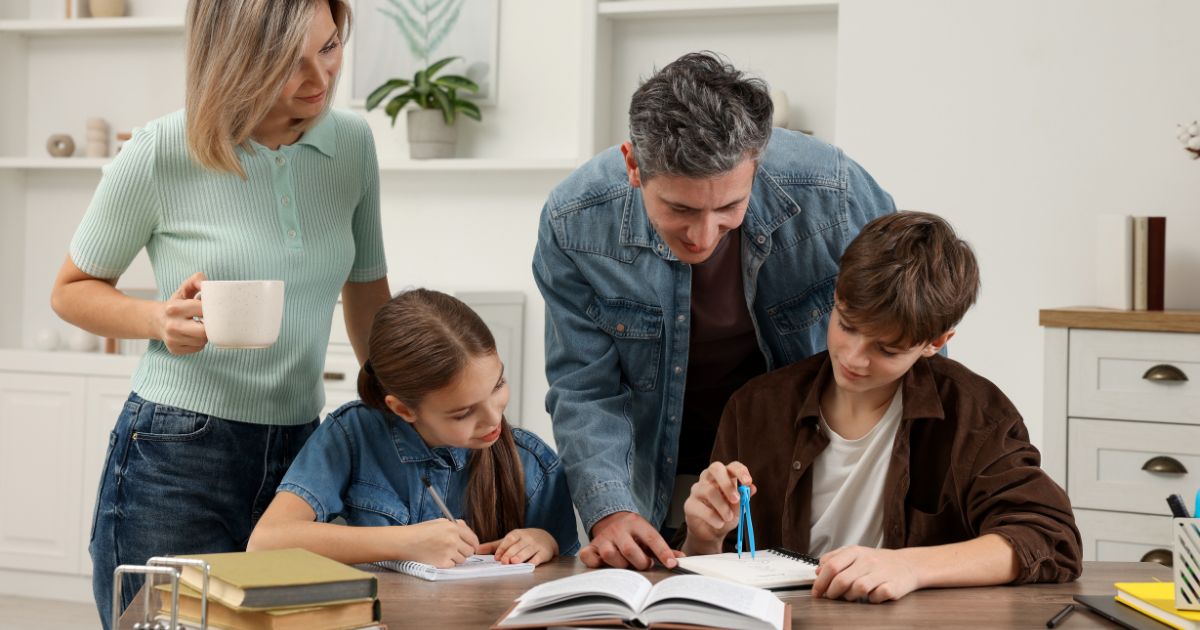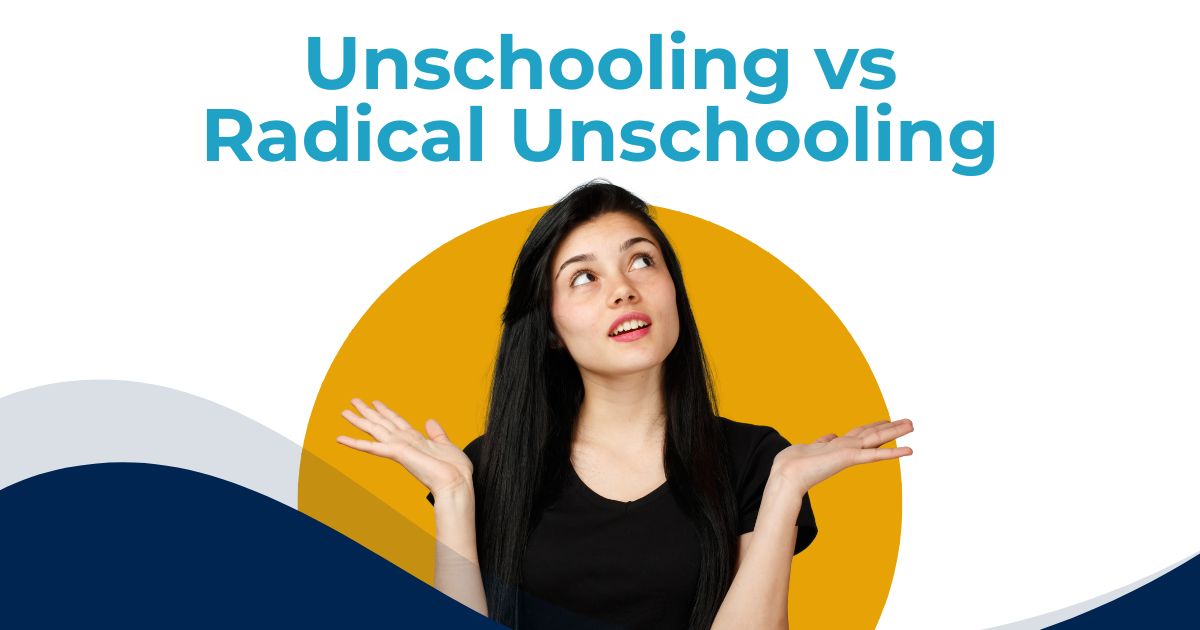If you’ve been down the homeschooling rabbit hole for a while, you’ve probably heard the phrase unschooling vs radical unschooling tossed around. They sound similar (and they are!), but they aren’t quite the same thing. Both approaches take a relaxed, child-led path to education —ditching textbooks, tests, and rigid schedules—but the philosophy and how far parents take it can look pretty different.
Let’s unpack what these methods mean, how they work day-to-day, and how they compare to other alternative education styles parents are exploring right now.
What Exactly Is Unschooling?
Unschooling is a learning philosophy based on the idea that kids learn best when they follow their natural curiosity. It’s not “doing school at home” — it’s creating a life full of opportunities to learn in organic, everyday ways.
Think of it like this: instead of a structured curriculum, your child’s interests drive the learning.
Here’s how unschooling typically works:
- Child-led learning: Your kid’s questions, hobbies, and passions set the agenda.
- No set curriculum: You might still use resources (documentaries, library books, online courses) — but only if your child wants to.
- Real-life experiences as lessons: Baking becomes math and science. Gardening becomes biology. Budgeting becomes practical math.
- Parental role as guide: You’re not the “teacher.” You’re more of a resource finder, supporter, and partner in exploration.
Unschooling is flexible. Some families blend a little structure in when needed (like using a math program for confidence), while others go fully interest-driven.
So Then, What Is Radical Unschooling?
Radical unschooling takes the philosophy of unschooling beyond academics — into every area of life. It’s not just about letting kids learn what they want; it’s about trusting them to make choices about everything.
That includes things like:
- Bedtime and sleep routines
- Screen time and technology use
- Food choices
- Chores and household participation
- Social boundaries and behavior
The core idea: trust. Radical unschoolers believe that children, when respected and given freedom, will naturally make choices that support their growth and well-being.
Instead of setting limits, parents model responsible decision-making and communicate openly. It’s about mutual respect rather than parental control.

Unschooling Vs Radical Unschooling: The Main Differences
Now that we’ve defined both, let’s look at where they diverge.
| Aspect | Unschooling | Radical Unschooling |
|---|---|---|
| Focus | Academic freedom | Total life freedom |
| Structure | Some parental boundaries (especially around daily life) | Minimal to no boundaries; full child autonomy |
| Parent’s Role | Learning facilitator | Equal family member and guide |
| Learning Environment | Child-directed but may include resources or light structure | 100% child-led and interest-based in every aspect of life |
| Discipline | Natural consequences or gentle guidance | Collaborative problem-solving and mutual respect |
In short, unschooling focuses on freedom in learning, while radical unschooling extends that freedom to all parts of life.
For some families, radical unschooling feels too open-ended. For others, it feels like the ultimate expression of trust and connection.
The Different Types of Unschooling Styles
Even within unschooling, there’s a wide spectrum. Every family customizes it to fit their comfort level and child’s personality.
Here are a few of the most common variations:
- Interest-Based Unschooling: The classic form—kids follow their curiosities and explore freely.
- Project-Based Unschooling: Kids dive deep into long-term projects, learning multiple subjects along the way.
- Academic-Light Unschooling: Some parents keep a loose framework for certain core subjects like math or reading but let everything else unfold naturally.
- Worldschooling: Learning happens through travel and exposure to different cultures, languages, and experiences.
- Hybrid Unschooling: Families blend unschooling with structured lessons or co-ops to get the best of both worlds.
Every version is flexible. The beauty of unschooling is that it adapts to your family’s rhythm — not the other way around.
How Unschooling Works in Real Life
If you’re wondering what an “unschooled” day looks like, the answer is: it depends! No two families look alike.
Here are some real-world examples:
- Morning: Your 9-year-old wakes up and watches a video about volcanoes. You help them find a DIY lava experiment on YouTube.
- Afternoon: You head to the grocery store, and your child helps compare prices, calculate totals, and read ingredient labels.
- Evening: They play Minecraft with friends, building a digital city — and learning teamwork, design, and problem-solving without realizing it.
The key is that learning happens naturally. Parents observe, suggest, and support — but rarely “assign.”
Benefits Parents Often See
Families who embrace unschooling (in any form) often notice big shifts in how their children engage with learning and life.
Some common benefits include:
- More genuine curiosity — Kids stay excited about discovering new things.
- Better mental health — Less stress and comparison can lead to calmer, happier children.
- Family bonding — Relationships become more cooperative and less authoritarian.
- Deeper learning — Children learn because they want to, not because they have to.
Unschooling also encourages independence, creativity, and problem-solving — skills that serve kids well in adulthood.
Challenges To Watch Out For
Of course, no education approach is perfect. Unschooling and radical unschooling both come with potential challenges.
A few to keep in mind:
- Parental burnout: It takes time, patience, and trust to follow your child’s lead.
- Outside pressure: Family or friends may not understand what you’re doing — or may think your kids aren’t “learning enough.”
- Documentation: Depending on your state or province, you may still need to log progress or meet legal requirements.
- Balance: Finding the right mix between freedom and structure can take time (and trial-and-error).
These challenges aren’t deal-breakers — they’re just part of the adjustment process. Most families fine-tune their approach as they go.
Comparing Other Alternative Education Styles
If you’re researching unschooling vs radical unschooling, you’ve probably bumped into other alternative education methods too. Here’s how they stack up:
- Montessori: Child-centered but structured, using specific materials and guided activities.
- Waldorf: Focuses on creativity, rhythm, and delayed academics, with strong teacher-led guidance.
- Charlotte Mason: Literature-based learning emphasizing good habits and “living books.”
- Reggio Emilia: Collaborative, art-driven early education focused on exploration and expression.
- Self-Directed Learning (SDL): Often overlaps with unschooling, but usually involves resources like learning centers or online mentorships.
Each approach offers a unique path. Some families even blend philosophies — using Montessori materials with unschooling principles, or combining Charlotte Mason reading time with child-led projects.
Tips for Parents Considering Unschooling or Radical Unschooling
If you’re curious about trying unschooling, start small. Here are some actionable steps to ease into it:
- Deschool first. Give yourself and your kids time to decompress from traditional schooling habits.
- Observe and listen. Notice what your child gravitates toward naturally.
- Create a rich environment. Stock your home with books, tools, art supplies, and access to experiences.
- Stay curious with them. Show that learning is a lifelong habit — not something that ends with a grade.
- Trust the process. It can feel uncertain at first, but kids truly do learn all the time.
You don’t have to go “all-in” from day one. Many families experiment gradually, finding the right level of autonomy that works for everyone.
Why Some Families Move Toward Radical Unschooling
Parents often shift from unschooling to radical unschooling when they notice how well autonomy works in learning — and wonder, “What if we applied this to life in general?”
They see that when kids have a say in their education, they also thrive when trusted with everyday decisions. Radical unschooling, then, becomes an extension of that trust.
It’s not about chaos or lack of boundaries — it’s about mutual respect, collaboration, and understanding that real learning happens through living fully.
Encouragement for Parents
You don’t have to fit into one label or philosophy perfectly. Whether you choose unschooling, radical unschooling, or something in between, remember this: you know your child best.
The ultimate goal is to create an environment where your kids feel safe, curious, and empowered to grow. The form that takes will naturally evolve over time — and that’s perfectly okay.
Keep Exploring Homeschool Insights
If this peek into unschooling vs radical unschooling has you rethinking what learning can look like, you’re not alone! The homeschooling journey is full of discovery — for both parents and kids.
For more insights, real-life examples, and helpful tips, check out our other blogs at DKM Homeschool Resource. Whether you’re exploring curriculum options, alternative learning paths, or ways to make home education feel more natural, we’ve got you covered.


